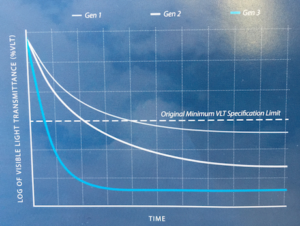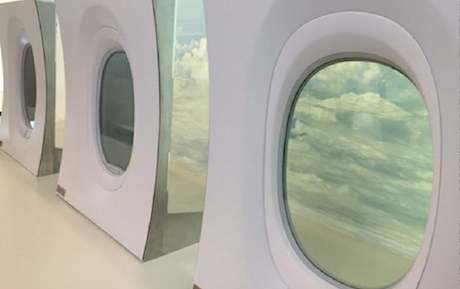The high-tech Boeing Dreamliner passenger experience could receive a subtle but significant upgrade soon. Following a tip-off from a cabin industry expert at Aircraft Interiors Expo that an exhibitor was showing “the next Dreamliner window” and a visit to the Gentex stand, the claim certainly seems believable. On display at the stand, mounted alongside the original ‘Gen 1’ window fitted to the B787 and the ‘Gen 2’ version, fitted to the aircraft since 2015 – both manufactured by Gentex – was a Gen 3 version, an evolution of the design in the final stages of development prior to market readiness in 2018.
A little background
A popular element of the Dreamliner passenger experience is the large electrochromic windows, which can be lightened or darkened at the touch of a button: a rare opportunity for passengers to interact with the aircraft itself (the technology is explained below). The windows also remove the need for mechanical shades, which in turn removes an item from the cabin cleaning checklist and a potential failure point. However, the initial versions were criticized for allowing in too much light at their darkest setting (<0.1% may not sound like much, but is noticeable in bright sunlight above the clouds). Thus in 2015 a second-generation version was developed by Gentex, which could go ten-times darker, with the transition from clear to dark taking half the time.
The third generation
Even at ten-times darker, Gentex has received feedback that there is demand for the window to go even darker, a task which the engineering department has been working hard to achieve. As Jordan Diekema, an analyst at the company, explained to Aircraft Interiors International, “Gen 3 is another ten-times darker still than Gen 2, so it is 100-times darker than the Gen 1 window.”
The window design has evolved from having a maximum capability of 99.9% darkness, to 99.9% darkness, to >99.999%, meaning that less than 0.001% of light gets through the Gen 3 in its darkest setting. This is good for sleeping passengers, as well as for cabin heat load.
As passengers expect the windows to be dark in their darkest setting, all but the most frequent flyers may not notice a difference. However, they may notice the new switch concepts for the Gen 3. The current passenger interface switch design is a tactile experience, with the button requiring a little physical pressure to cycle between its five stages of tint. For Gen 3, however, ideas being evaluated include two ideas for simpler, easier-to-clean capacitive touch switches, and two capacitive touch slider control designs.

Diekema explained the benefits of these control concepts, which are being developed in-house at Gentex. “They are maintenance free and should last life of the plane. With capacitive touch switches on the dustcover, you remove the problem of wear and tear on buttons. The controls are also more logical to use [with the slider you simply place your finger at a desired point on the darkness scale], and you can have as many states of darkening as you want. The B787 windows have five states today – from fully clear, to three intermediate states, to fully dark – but with the Gen 3 controls you can have as many intermediate states as you want.”
Diekema stated that nothing has been signed yet, so Gen 3 is not in shoe-in for the Dreamliner. However, as an established window supplier for the aircraft, with an improved version of its design almost ready for release, this is a technology worth watching out for.

How it works
The interactive window system on the Dreamliner uses a similar electrochromic formulation to the one used in the electrochromic technology that Gentex developed for its auto-dimming automotive rear view mirrors.
Electrochromic technology uses electricity to change the color and light transmission of a transparent medium – a medium containing materials that are capable of generating color. This medium is an electronic gel medium sandwiched between two thin, transparent panels. An electric current is passed into the conductive coatings and across the panel, which creates an electrochemical reaction in the gel.
Applying a small electrical DC voltage across the gel – by pressing the window button – causes it to darken, while removing the voltage allows the gel to return to its natural, transparent state. The voltage can be precisely controlled and adjusted in small increments to allow for the selection of intermediate states of light transmittance.





